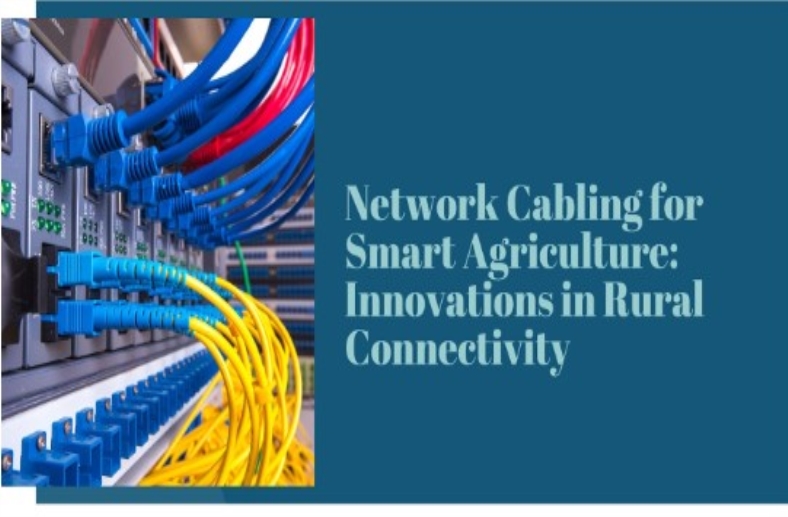Connectivity is the lifeblood of smart agriculture. As farming operations become a little more data-driven with each passing day, robust network infrastructure is essential for driving efficiency, productivity, and sustainability.
However, rural areas face unique challenges when it comes to connectivity. This is due to several factors such as distance, terrain, and sparse population density. Innovations in network cabling are addressing these challenges and transforming rural agriculture.
Challenges in Rural Connectivity
Approximately 26 million rural Americans lack access to broadband internet, according to the Federal Communications Commission (FCC). This severely impacts their ability to implement modern precision agriculture techniques that rely on data analytics and connectivity.
Rural areas have to contend with barriers like rugged terrain, forests, hills, and large distances between farms. These factors make deploying traditional network infrastructure expensive and impractical. Sparse population density also dissuades network providers from investing in rural areas.
Studies by the American Farm Bureau Federation estimate that inadequate rural connectivity leads to economic losses of up to $47 billion annually in the agriculture sector. The inability to adopt smart farming practices results in decreased efficiency, lower yields, and lost opportunities.
Innovations in Network Cabling for Smart Agriculture
Advanced network cabling technologies are overcoming rural connectivity challenges and enabling cutting-edge smart agriculture capabilities.
As innovative cabling and connectivity solutions arise, having an experienced network integrator can help farms and agricultural businesses design, install, and maintain advanced wired and wireless networks. Farmers in Florida should seek companies that provide expert network cabling in Doral Florida and beyond to enable them to deploy smart agriculture infrastructure.
Fiber Optic Cabling
Fiber optic networks allow reliable high-bandwidth communication over long distances making them ideal for rural areas. Light signals transmitted through glass fibers suffer minimal signal loss compared to traditional copper cabling. Fiber can support speeds up to 10 Gbps and distances up to 25 miles without repeaters. This enables real-time data transfer from sensors across large farms to drive data analytics and automation.
Wireless Mesh Networks
Mesh networks create a web of interconnected wireless access points to transmit data over large areas. This provides expanded Wi-Fi connectivity across expansive farms without extensive cabling. Nodes automatically reroute connections if one fails, increasing reliability. Solar-powered mesh networks are an economical solution for off-grid rural locations.
Cellular Connectivity
Cellular connectivity like 4G LTE provides wireless data transmission over long ranges but often has limited rural infrastructure. However, new 5G networks promise greater capacity, lower latency, and faster speeds supporting next-gen precision agriculture use cases. Cellular networks can provide blanket coverage across vast rural expanses.
Low-Power Wide-Area Networks
LPWAN technologies like LoRaWAN and NB-IoT enable long-range rural networks for IoT devices using little power. LoRaWAN’s wide coverage makes it optimal for dispersed sensor networks. Miles-wide base station range and robust data transfer make LPWAN suitable for remote monitoring applications in agriculture.
Case Study: A farm in Iowa deployed an NB-IoT network connecting soil probes across 1,000 acres of fields. This provided insights to enhance crop health and optimize fertilizer usage.
Satellite Internet
High-throughput satellite internet services like SpaceX’s Starlink are launching thousands of low earth orbit satellites to provide broadband globally, including rural and remote regions. With capacities up to 100 Mbps, satellite internet can support bandwidth-intensive precision agriculture capabilities like HD video monitoring, AI-enabled analytics and high-speed equipment control.
Benefits of Advanced Network Cabling
Implementing advanced network cabling solutions unlocks significant benefits for farming operations. These benefits can be in the form of increased Profitability or efficiency, but they all come together to enhance the network capabilities of the business.
Some of the benefits include:
Increased Yields and Profitability
- To increase yields and profitability, farmers can make use of wireless sensor networks to provide insights that will help them to optimize growing conditions. This will boost crop yields by 20% or more. Real-time soil analysis can also be performed, and this enables precise fertilizer application when and where it is needed.
- Smart irrigation systems can also be used which will dynamically adjust watering schedules and rates, based on weather and crop water needs as informed by in-field sensors.
- Farm assets can be tracked through wireless networks, allowing the monitoring of cattle location and health, thereby reducing losses. Automation can be enabled by connectivity, and by doing so will reduce the reliance on manual labor.
Operational Efficiency
– Networked equipment and machinery enables real-time status monitoring, predictive maintenance, and over-the-air software updates, all of which serve to reduce downtime.
– Remote monitoring through video networks provides security and allows assessing crop health or livestock conditions from any location.
– Real-time fleet tracking through combine harvesters, trucks, and tractors provides operational insights and allows remote coordination especially during critical harvesting seasons.
Sustainability
– Optimized irrigation and fertilizer application reduces runoff, improving soil health and minimizing environmental impact. Studies show 20% higher energy efficiency on farms with data-guided operations.
– Connectivity provides granular data to prove sustainability practices to customers and regulators. Streamlined supply chain through connected logistics further reduces environmental footprint.
Key Takeaways
– Fiber optic cabling can be used to provide long-distance, high-speed data transmission for real-time analytics.
– Wireless technologies like LoRaWAN serve to enable expansive rural sensor networks.
– In remote regions, satellite networks can be used which pffer broadband connectivity.
– At the end of the day, advanced cabling increases yields, reduces costs, and improves sustainability.
Future Outlook and Trends
There are several emerging technologies that wiill further enhance rural network connectivity in agriculture. Some of them are:
– 5G Networks, which promise faster speeds, lower latency, and increased capacity compared to 4G LTE. This supports more data-intensive agricultural applications for farmers.
– LEO Satellite constellations like SpaceX’s Starlink that aim to offer global low-latency broadband coverage, for both rural and remote areas.
– Solar-Powered Networks with their energy harvesting sensors, and long lasting batteries will also make off-grid networks in remote locations more viable.
– AI and Automation will drive precision agriculture and allow harnessing network data to become more efficient and sustainable, even with limited connectivity.
As time goes on, research and development will continue to progress and open new possibilities as connectivity cements its role as the backbone of smart agriculture.
Conclusion
Advanced network cabling will provide the connectivity essential for unlocking the potential of smart agriculture, even in the hardest-to-reach rural areas. Rural communities face unique challenges that need to be tackled with innovative ideas and technological resources.
Technology innovations are being developed and implemented that are overcoming the specific challenges faced by rural communities that are trying to adopt precision farming practices. By embracing new solutions like fiber optics, LPWAN and satellite internet, the agriculture sector can increase efficiency, productivity and sustainability. The future is bright for tech-savvy farming!
Frequently Asked Questions
What are the main obstacles in providing connectivity to rural agricultural areas?
The primary challenges are the large distances, difficult terrain, high infrastructure costs and low population density in rural areas. These factors make it difficult for traditional cabling or wireless networks to provide cost-effective connectivity.
How can network cabling innovations increase productivity in smart agriculture?
Real-time data from sensors and automation enabled by cabling improves yields, optimizes resource usage, allows data-driven decision making, and reduces operational costs – all contributing to increased productivity.
What should farmers consider when choosing a network cabling solution?
Key considerations include network bandwidth and latency needs, distance and terrain constraints, power availability, deployment and maintenance costs, and scalability requirements as the farming operation evolves.

